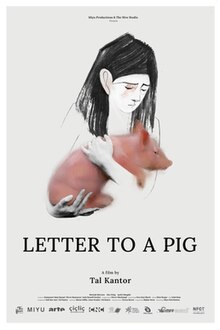Eye For Film >> Movies >> Letter To A Pig (2022) Film Review
Letter To A Pig
Reviewed by: Jennie Kermode

When director Tal Kantor was a child, an old man came to her school to talk about his memories of the Holocaust and a letter he had written to a pig who saved his life. That night, Kantor had a dream so vivid that it stayed with her for 17 years. Eventually she had to get it out of her system, if only so that she might have a better hope of understanding its symbology, and so she created this short film, now shortlisted for an Oscar.
There’s an understanding amongst human rights workers that if people have not experienced a particular kind of abuse themselves, they will empathise more strongly if they are shown only a moderate amount of it. Showing them the worst means they’re less likely to believe it and even when they do, they can’t relate to it. This makes talking about the Holocaust more and more difficult as it recedes not only from living memory, but so far into history that only a tiny proportion of the world’s population now personally knows someone who was affected by it. To the kids in the class we see represented here, the very enormity of it makes it hard to take seriously, and they react with laughter. but something gets inside the mind of a girl in that classroom just as it got into Kantor’s mind.

The animation is loose, impressionistic; swirling streaks of ink form and reform, only occasionally coalescing into solid lines. It suggests that the students don’t really see the old man before them. They’re unfocused, thoughts drifting as they hear his words. The pigs, at first, seem threatening. in first person perspective, we move to take shelter in their barn. Soldiers are coming. We are the figure hiding in the hay. Capture seems certain, but a pig steps into the way, concealing the fugitive, earning an affectionate pat from a Nazi officer who was perhaps a farmer himself, focused on nurture and growth, before the war reshaped him.
The old man pent months in the barn, he recalls, living with the pigs, eating their food. it was particularly distressing for a Jewish man who had always seen them as unclean creatures, and that degradation robbed him of some of his sense of self, yet that one pig’s decision to save him, something he is certain was a conscious choice, changed his understanding of them, forcing him to confront his own prejudices.
Kantor’s film is a reminder of how difficult that process of self-reckoning is, especially for teenagers, especially in a group setting. Ideas emerging from the old man’s story become confused, so that it’s less clear where the danger lies, where power lies. All that remains clear is the sense of horror, a deep awareness that something too awful to picture clearly marked this man and marked the world, leaving a scar upon it. Where the film begins mostly white, with simple shapes to illustrate the class, it gradually draws the viewer down into swirling darkness.
Reviewed on: 31 Dec 2023
















